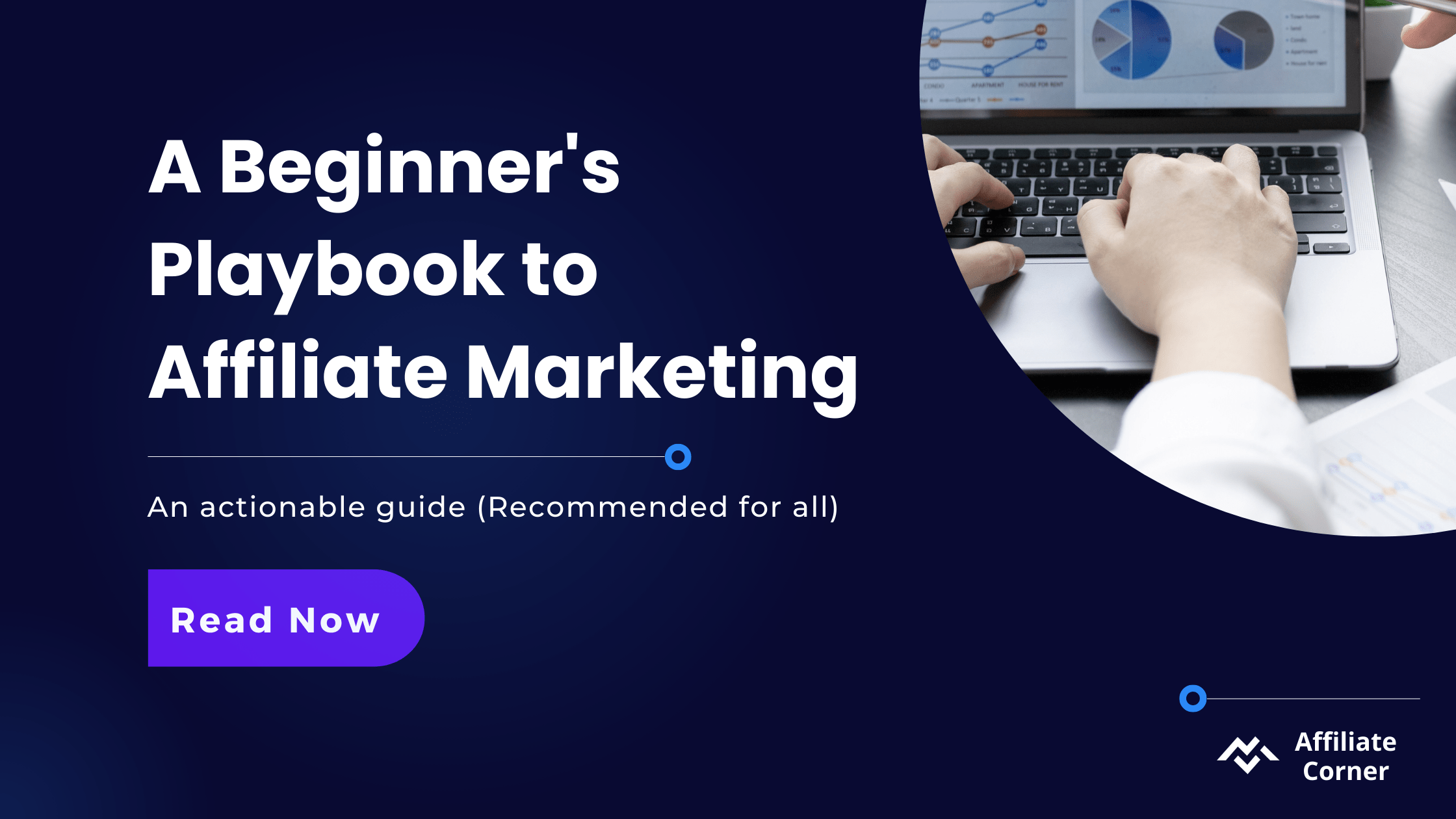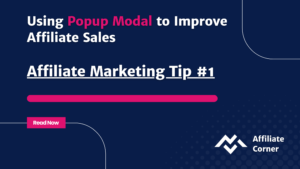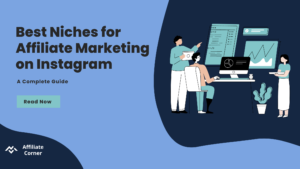Note: This will be one of the actionable guides in Affiliate Marketing. You can bookmark this article as it will help you a lot.
Are you confused about where to start with Affiliate Marketing? Don’t know what niche you should start in? Don’t know how to get traffic to your affiliate offers? Most importantly, are you looking for actionable steps to get started?
You are in the right place!
In this blog post, I will share how you can get started in Affiliate Marketing as a beginner. I wish someone could have written this post when I started and was confused and under-confident.
I know many courses and blogs about general affiliate marketing ways, techniques, and strategies. Still, in this post, you will get some really new ideas about how to approach Affiliate Marketing.
After reading this post, I hope the picture will be clear for you.
- What is Affiliate Marketing?
- Types of Affiliate Offers
- Skills Needed to Start Affiliate Marketing As a Beginner
- The skill stack I recommend you to start with
- What is a Niche & Is It Really Important?
- How to find a niche for your affiliate site
- How to find the best affiliate programs to promote?
- 5 Things to Consider While Choosing an Affiliate Program
- How to promote affiliate offers (even if you are a beginner)
- How to maximize your niche website’s earnings with Affiliate Marketing
- Google’s view on Affiliate Marketing & How it can impact you.
- The Affiliate Marketing Stack You Need in 2022 & Beyond
- My Final Thoughts
What is Affiliate Marketing?
Affiliate marketing means you will get paid a commission for promoting someone else’s product or service. How you earn money can be different and changes according to affiliate offers.
But the most commonly used term is CPS (Cost per sale).
That means, if someone buys from your link (affiliate link), you will get paid as per the commission percentage of the affiliate program.
Now that you know the meaning of it let’s get into the types of affiliate marketing and offers.
Types of Affiliate Offers
Cost per sale (CPS):- You will get paid only if the customer purchases a certain product or gets a service through your link.
The commission percentage differs from company to company.
Cost per action (CPA) or Cost per Lead (CPL): You will get paid for any customer action. Example: It can be a simple installation of an app. Suppose you are promoting dating apps, you can simply get paid if anyone installs the app. This can also be categorized into CPI (Cost per install)
Now, the commission might not be huge, but this has more probability of you getting the commission than CPS.
Some more actions can be:
- Subscribing to a newsletter
- Starting a paid trial
- Depositing money into the product (Eg: Casino, Betting platforms)
- Signing up for a SaaS Platform
Rev Share: In this model, you will get paid a certain percentage of revenue generated by the customer. This mostly happens in the broking industry, where you get paid on the broking revenue generated by the trader/investor.
Let’s not get confused about these models.
Once you start, you will get a complete overview of what this means. Let’s talk about what is important: SKILLS needed to start.
Skills Needed to Start Affiliate Marketing As a Beginner
Let me tell you frankly, Affiliate Marketing is not easy as it looks. Not trying to scare you or refrain you from starting this.
But selling is difficult. Making a sale is always difficult.
That is why sales & marketing are always in huge demand. Companies often look for people who can help them market and make sales.
As an affiliate marketer, your job is to make a sale. That’s it.
So, I am listing down some skillsets required for affiliate marketing as a beginner. Note that not all the skills are mandatory.
Even if you master 1 of them, it will get you a big kickstart.
- SEO (Search Engine Optimization)
- Email Marketing
- Community Building
- Content Marketing
- Social Media Marketing
- Website Building
- CRO (Conversion Rate Optimization)
- Paid Ads
- Copywriting
Out of these, CRO, Copywriting is a complimentary skill. You can learn along the way, and it is usually recommended to improve your sales.
SEO is one of the most important skillsets you can possess. Let me tell you one thing, even if you fail or succeed in Affiliate Marketing, you will never regret learning SEO. That’s for sure.
The skill stack I recommend you to start with
If I were to start affiliate marketing from scratch, I would go with a bottom-up approach.
Here’s a bird’s eye overview of how I strategize my affiliate marketing:
- Pick a niche that I am interested in or know about
- List down all the possible channels where I can get relevant traffic
- Start tapping 2-3 channels
- Know which one is working and double down on it
So it really depends on what type of audience you are targeting.
For example: If you are trying to promote a B2B Cold Sales Software, it would be a disaster to start with Pinterest
So know which audience resonates better on which channel. Perhaps, LinkedIn is better for B2B.
I would approach by connecting with the person and discussing the tools and softwares he uses. And later, perhaps, I can consult him for free in return for him using my affiliate link for purchase.
Because I know my commissions can be huge. So I would consult him for free.
This is an example of how I would approach it for cold sales software. Note that I could execute many strategies, but the “LinkedIn Cold Outreach” is one method I shared as an example.
Coming back to SEO.
SEO is important. It is passive traffic; if done properly, you will look at that holy grail of passive income.
It takes time. It takes a lot of effort.
And even if the word “passive income” attracts you, you need to work on your website daily, so your traffic and ranking never drop.
Wrapping up, I would start with the channel that resonates the most and do SEO from Day 1.
If you really want an overview, you can start with:
- SEO
- Email Marketing
- Social Media
Now that you know the skills you require let’s talk about “Niche” and why people keep calling it a “Niche Site“.
What is a Niche & Is It Really Important?
Niche is basically a topic around similar interests. So if you were interested in Golf, you would probably start a website around Golf. And then “Golf” is a niche.
If you like “Hockey” too, then “Hockey” is another niche.
Later, we can categorize this as a broad and micro-niche.
“Sports” would become a Broad Niche under “Golf” and “Hockey”
As an affiliate marketer, if you are building a website, you should stick with one “Broad Niche” and then talk about topics under it.
Example: You like golf very much. You know the in’s and out’s of it. So you think that I should be promoting golf products under my website?
That’s fine. If your goal is to promote only golf products, then take a domain name that resembles “Golf”. Can be “Golfmentor.com” or “Golfstudy.com”
But if you want to diversify your affiliate offers and think, I want to promote “Sports affiliate products”, then it is highly recommended that you go with a broad domain name such as “Sportsmania.com” (Just an example).
Here’s a clearer picture:
- Pick a broad niche for promoting affiliate offers (Eg: Sports)
- Similarly, pick a domain name that resembles your broad niche (Eg: Sportsmania.com)
The benefits of these are:
- You can develop many content ideas and never run out of them.
- Tons of opportunities to promote affiliate offers under the broad niche
- Google will see your broad domain as an authority (as you churn out related topics)
I hope you have understood the term “Niche” and why it could play an important role.
Many of you were asking about “How to find a niche” let me share some ways you can do it. Obviously, this can be a separate post too.
How to find a niche for your affiliate site
Are you confused about which niche to choose while starting your affiliate site?
Here’s a simple framework you can use: (Taken from my mega thread on Twitter)
Choose something that you are personally interested in.
Make a list of all the hobbies or interests you have.
Jot them down in a google doc.
It can be anything:
- Woodworking
- Gardening
- Walking
- Painting
- Guitar
- Football
Now pick just 5 of them you like the most and plug them into Google Trends.
Choose a location in the United States
For example, I do a search for “Woodworking”
If you see, there’s a lot of demand, but it’s quite seasonal.
Search interests go up in Dec.
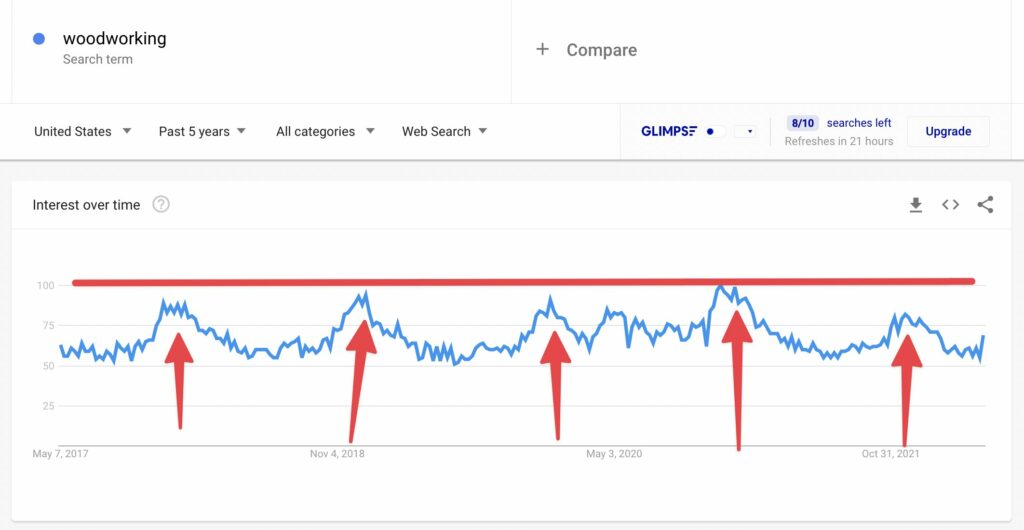
Out of the 5, you can pick that has growing or evergreen demand.
Seasonal niches are okay, too but only choose after analyzing all the evergreen niches.
Evergreen niches are those that people search for almost all year.
Avoid seasonal niches if you don’t want your income to fluctuate.
But if you are really interested & passionate, then you should not stop. It’s not a hard and fast rule.
Once you choose this broad niche called “Woodworking“,
You need to find a micro niche under it.
A simple google search will help you find more micro niches under “woodworking”
Now, this is where you play your game. You won’t find much competition in micro niches.
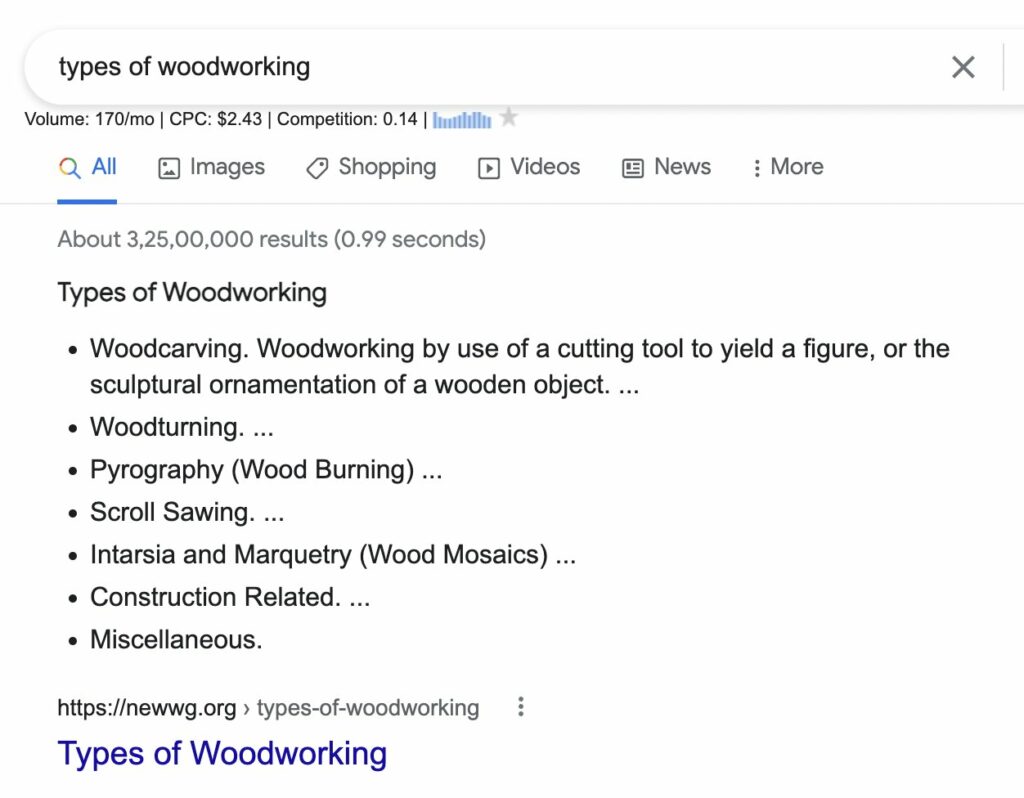
Last but not least, if you choose to go with any micro-niche and run out of keywords,
Then choose another micro-niche under the main niche.
This way, you are also building topical authority for “woodworking”
Now just replicate woodworking with other interests or hobbies. You got a framework you can replicate for almost any interest or hobby.
Still not sure where to start?
Here’s a list of 1000+ hobbies and interests you can explore.
I hope this has cleared much of your doubts regarding niche-picking.
If you want more information on how to check profitability or know if it is a commercially good niche, I have done a separate thread here. Will do yet another blog post soon on this topic.
How to find the best affiliate programs to promote?
Once you have identified a niche, it is time to find affiliate programs so that you can start promoting.
Usually, many people sign up on “Amazon” and promote products from there. Because of the high conversion rate and the likelihood of someone buying from Amazon is better than any brand (simply due to Brand Authority and purchasing behavior)
But Amazon’s commission rates are poor. Ranging from 1% to 5% and beyond, it gets justified as the conversion rate is often high.
You can sign up for Amazon Associates Program and start promoting offers immediately after approval.
Other ways to find affiliate programs:
Simply do a search on Google: “Your Niche” + “Affiliate Program”
If your niche is Golf, search for “Golf Affiliate Programs”.
You will find a lot of affiliate programs in the Golf Category.
Using Affiliate Corner
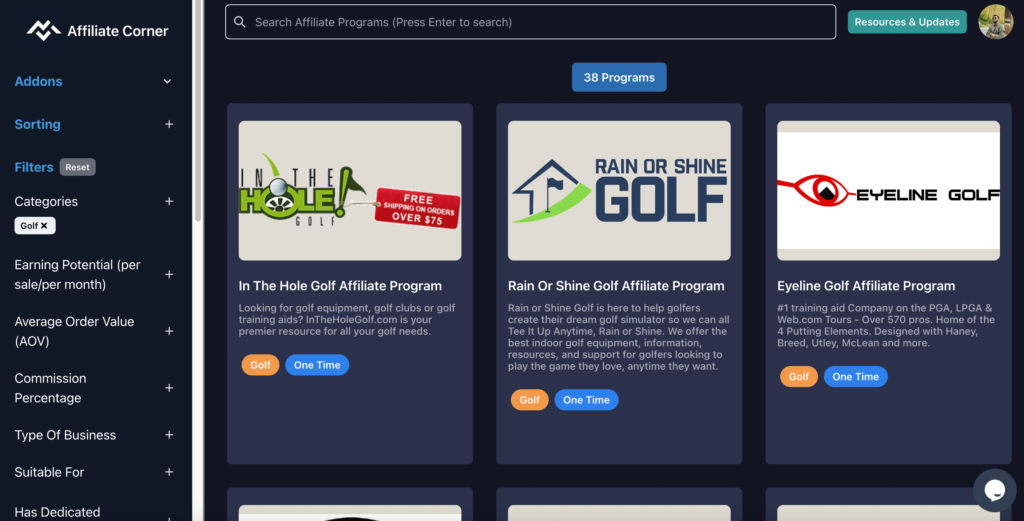
You can use Affiliate Corner to find, explore, and filter Affiliate Programs of your choice. The best part about this is that it can seamlessly filter across almost 20+ data points.
What’s even more interesting is:
- You can get keyword insights on which keywords to target in your niche
- Promotion strategies as an affiliate
- Audience insights (who you should be targeting)
& much more.
Affiliate Corner is a handy tool that can help you save time and money in research.
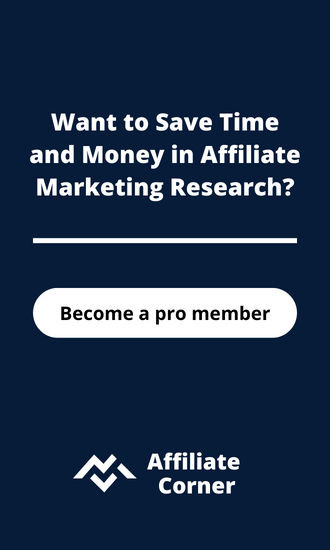
Affiliate Corner
Search & Filter Thousands of Affiliate Programs & Unlock Niche Insights
- Download Low competition keywords to target
- 15+ promotion strategies for every niche
- Audience & commission insights for every niche
- 20+ data points to filter affiliate programs
- Ever-growing database & lifetime updates
5 Things to Consider While Choosing an Affiliate Program
Once you decide to do affiliate marketing, the first thing you look at is choosing an affiliate program.
Here are some tips to help you choose the best affiliate program:
- If the product is an industry leader with a good brand reputation, just go for it.
- Always ask your affiliate manager the type of audience that converts well. The manager has a lot of insights, and they usually help (if at all the company has a dedicated affiliate manager)
- The higher the cookie life, the better it is. The cookie life is nothing but duration from when someone clicks on your affiliate link to the time the user purchases it.
- If the cookie life is 90 days, that means even after 90 days, that user buys the product, you will get attributed towards that sale.
- Recurring commissions are recommended if you want that recurring source of income. Yes, making those sales is difficult but worth it. Imagine a recurring source of revenue just by recommending the right things.
Pro Tip: Affiliate Corner can help you select the best affiliate programs with more than 20+ filters.
Best part? You can get all the insights such as keywords to target, promotion strategies, and more.
Now once you have got your affiliate link. It’s time to make a sale. How would you even proceed?
Let me share some strategies to promote affiliate links (even if you are a beginner). I will do a separate in-depth post on this later, but you will get an idea.
How to promote affiliate offers (even if you are a beginner)
Let’s talk about SEO.
Major of the affiliate marketing sites you see earn through their website. How do they get so much traffic?
Do you know an affiliate website called “VPNMentor” was sold for a whopping $150M?
VPNMentor’s most traffic is from SEO – 83% and the rest is Direct, Branded Traffic.
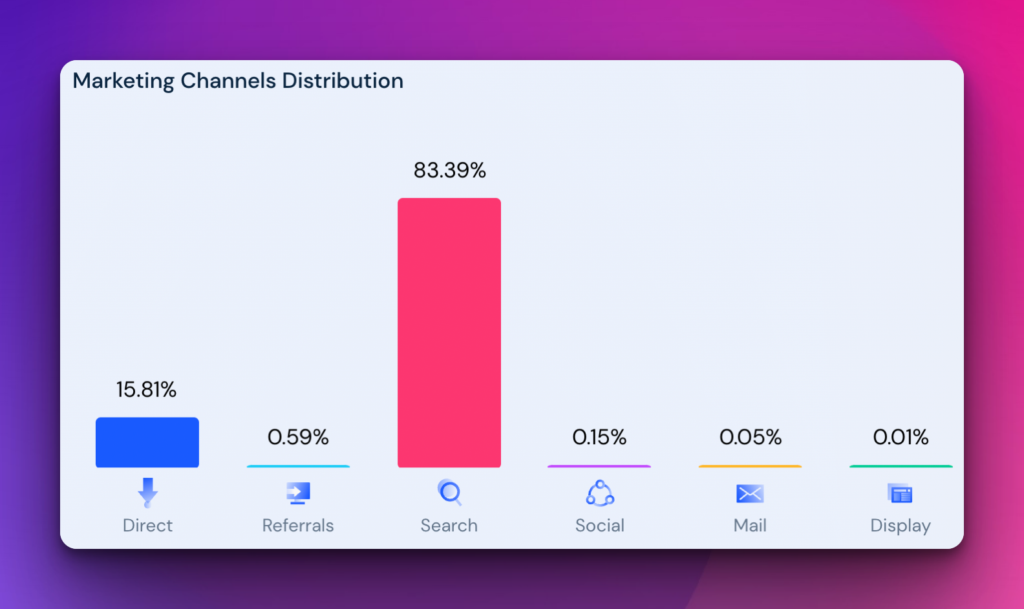
The point of sharing these screenshots and stat is: You should not ignore SEO at any cost!
There are many ways you can start promoting your affiliate offer. Here are some ways you can do it:
1. Email Marketing
Start building an email list from Day 1.
Owning your audience is the number 1 thing you can do today.
- Setup autoresponders
- Have an automated flow of emails
- Use the 80-20 rule (80% value, 20% promotion)
- Promote affiliate offers in the signature
The best tool to start: MailerLite. Free up to 1000 subscribers. Built-in Automation flow. Easy to use.
2. Own a Facebook Group or any community
The future is community.
There are a lot of opportunities and like-minded people out there who want to discuss a topic.
Start a FB Group. Probably the easiest to get started. Grow & scale it up.
Promote affiliate offers as admin 🙂
I know many FB groups making a ton of money through affiliate marketing. Mainly in the SaaS industry. Will do a case study soon.
3. TikTok
TikTok is getting exploding organic reach right now. Just lead users to your bio link.
You can take them to your website or email list (where you have the autoresponder setup).
💡Pro tip: You can show your URL on TikTok video & watch out for direct traffic. People usually search the URL or website name on Google. So you can get direct traffic to your website.
4. Setup free lead magnets and attract traffic from Social media
The goal is to get relevant traffic. Create a lead magnet.
It can be:
- Checklists
- Templates
- Videos
- Quizzes
Host it on your website and share it on social media. Ask for email & nurture those subs.
These email subscribers are now your audience. Then just follow the 80-20 rule and promote accordingly.
5. Paid Advertising
Not recommended for beginners. You can run paid ads on dedicated landing pages or high-intent blog posts.
Just make sure you are running ads on affiliate programs which can be hugely profitable.
Otherwise, your CPA will eat all your profits.
Some more bonus channels for you to promote:
6. Pinterest
Create relevant Pinterest pins and pin them on a dedicated board. Take them to your website or a landing page for the destination URL.
Don’t underestimate Pinterest traffic at all. If you do it consistently, you can get a lot of high intent traffic on your website.
7. YouTube
With YouTube, you can start review-based videos and explain the product. The best part about Youtube is you can cross-promote this video to your social media and embed the same on your blog post.
Leave your affiliate link or your website link in the video’s description.
I will do a separate in-depth post on “Promotion strategies for affiliate marketers”.
How to maximize your niche website’s earnings with Affiliate Marketing
As I told you above, you can get started and promote affiliate offers in multiple ways. But having a dedicated website is where the game changes.
It is like digital real estate and an asset you own.
& that real estate can be listed on one of the best areas of the Internet – Google.
Here are 6 ways you can maximize your earnings once you start getting traffic:
- Target high-intent keywords and promote affiliate offers:- These can be keywords such as “Product Reviews, Product comparisons or any term where buyers are directly looking to make a purchase)
- Create dedicated landing pages:- If you are making a review, you can create dedicated landing pages. This way, you can customize it for a better conversion rate and even run ads on it later on.
- Have a resource section on your website:- A resource section is where you will list your recommended products. Users can easily check out and buy from it. Often added on the website’s top menu to be easily visible.
- Improve CTR by using product blocks:- The more clicks you get on your affiliate links, the more you earn. As simple as that. Use products like Affiliate Booster or GetLasso, to improve your CTR.
- Create in-depth review posts:- Whenever you do product reviews, make them in-depth. Follow Google’s guidelines here. You have a higher chance of converting a customer from review posts.
- Promote affiliate offers with the highest cookie life:- Cookies are tracked whenever someone clicks on your affiliate link. If they purchase after 28 days (programs often specify the time), you will still get attributed towards the sale. So more the cookie life, the better it is.
- Pro tip:- With Affiliate Corner, you can easily filter cookie life within seconds.
I hope these tips will immensely help you once you start. Next, I want to discuss Google & its take on Affiliate Marketing.
Google’s view on Affiliate Marketing & How it can impact you.
Google wants the best of the articles to rank on Google. They have special algorithm updates for affiliate marketing sites that review products and make money.
In fact, they have provided dedicated guidelines on “How to do product reviews”.
You can read the documentation here.
This is mostly done for physical products/eCommerce products.
But to be safer, try to align with all the best practices for any review article you write.
I have seen websites getting absolutely hammered after algorithm updates, and Google prefers more authority sites than general sites trying to spam users with affiliate links.
I would highly recommend this: Whenever you start any niche affiliate site, try to make it a brand rather than just a normal website.
When you add the brand angle to your website, it will help you in the long run and also make your website authority increase (ofcourse there are a ton of other things that go into authority)
There’s a neat little hack I do so that it is not under Google’s radar. I would probably write an in-depth post on it later. But here’s how it works:
Often all affiliates try to write on those high intent keywords that can get a sale. But you know what?
You can even get affiliate sales on Top of the Funnel Informative Content.
This means that even if that user is not looking to buy and you just have some informative content on that topic, you can try to subtly promote your offer wherever relevant.
I know this will require a new post altogether. So let’s keep this for another day.
The Affiliate Marketing Stack You Need in 2022 & Beyond
Let’s see what tools and softwares you need to get started. Note that not every tool is mandatory, but some are recommended.
- WordPress CMS:-Easiest CMS to get started for building your affiliate site.
- Domain:- Any Domain Registrar is good to go. I prefer Namecheap.
- Hosting:- First go with any shared hosting, later upgrade to a good one.
- Keywords Everywhere:- Most Affordable Chrome Extension for SEO
- Thirsty Affiliates:- Cloak Affiliate Links & Reporting
- Grammarly:- Check grammar and improve writing vocabulary
- Affiliate Corner:- Affiliate Programs & Niche Research
- Affiliate Booster:- Improve CTR on Affiliate Links
These tools have immensely helped me on my affiliate site, and I hope they will help you.
I will do a separate post on each of these tools to help you understand how it can help you maximize its potential.
My Final Thoughts
It is always good to have an extra source of income. Affiliate Marketing can certainly be the way for you. Yes, it takes time. It takes a lot of learning. But without effort, you won’t have that kind of success you see on the Internet.
Here’s what I think your plan should be:
- Start a niche website. Pick a broad topic to write upon.
- Once you start writing SEO-driven articles, you will get traffic.
- With more traffic comes more opportunities.
- You can monetize and diversify your revenue model with display ads, affiliate offers, sponsored posts, etc.
- The goal is to start driving traffic. It can be either via SEO or other channels I mentioned above.
I hope this beginner’s guide to affiliate marketing has helped you get some clarity. Thank you for reading.
Please feel free to share this on Twitter by clicking on this link.
Thank you for reading.
Affiliate Corner
Find 3000+ affiliate programs across 20+ data points & unlock data-driven insights into many niches. Saves you 100s of hours & $1000s in research.

